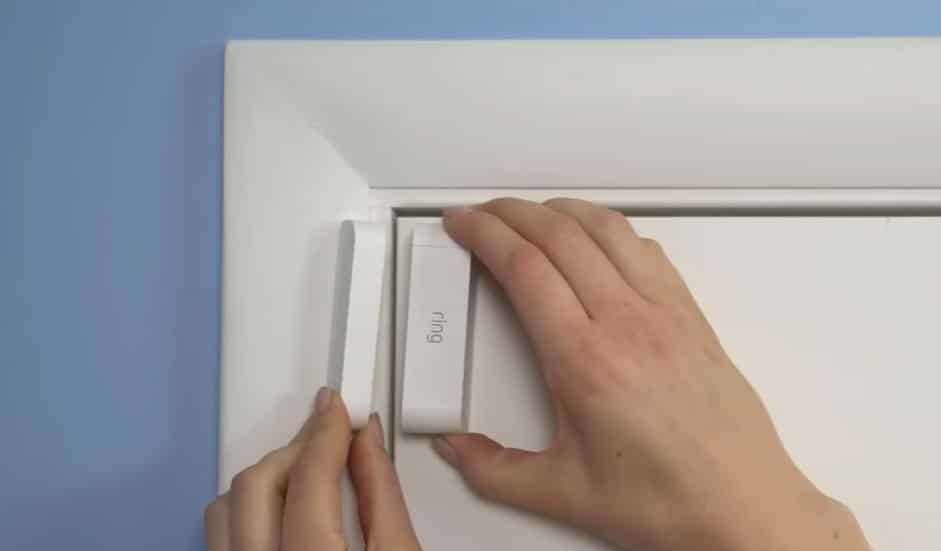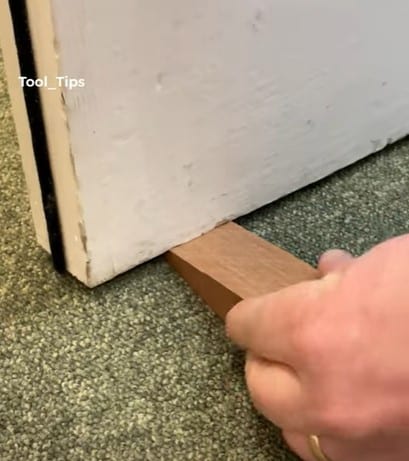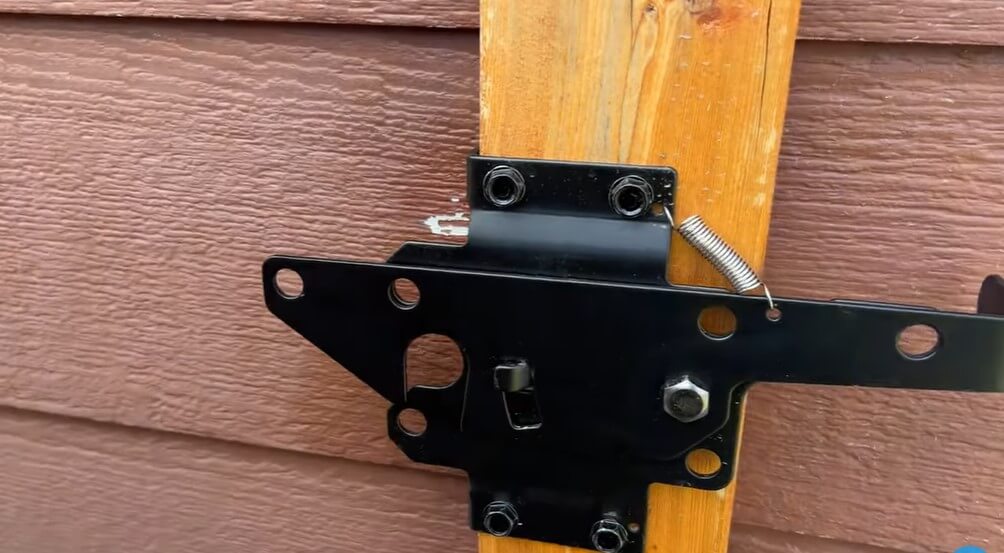To secretly keep a door from locking, use a doorstop or tape. Now, you may be wondering why someone would want to keep a door from locking.
Perhaps you want to ensure easy access to a room or avoid getting locked out by accident. Whatever the reason, there are ways to keep a door unlocked without arousing suspicion or damaging the door. In this article, we’ll explore some simple yet effective methods for covertly preventing a door from locking.
Whether you’re trying to keep a door unlocked temporarily or long-term, we’ve got you covered! So, let’s dive in and learn how to secretly keep a door from locking.

Why You Need To Keep A Door From Locking?
There are various reasons why you might need to keep a door from locking. Here are some of the most common:
1. Avoid Getting Locked Out Of A Room
Have you ever been locked out of a room? It’s a frustrating experience, especially if you urgently need access. However, with a few simple tricks, you can prevent this occurrence. Here are some key points to remember:
- Tape over the latch: Applying tape over the latch will prevent it from being pushed in, hence avoiding locking.
- Use a doorstopper: Placing a doorstopper beneath the door will prevent it from closing and subsequently locking.
- Install a door wedge: Inserting a door wedge between the door and the frame will keep the door open without the risk of locking.

2. Keep An Area Secure Without The Use Of A Lock
Sometimes you need to keep a door unlocked but still secure. Here are some key points to help with that:
- Use door alarms: Hanging a door alarm on the knob will alert you if anyone tries to enter through the door.
- Install a door barricade: A door barricade is an excellent tool to keep a door secure without the use of a lock. It’s easy to install, removes the risk of lockouts, and provides security.
- Place a chair against the door: Pushing a chair against the door handle will create a block, making it challenging for anyone to enter.

3. Prevent Unwanted Access To A Room
There are times when you need to keep people out of a room. Here are some ideas to keep the room secure:
- Use a door blocker: A wedge-shaped door blocker can prevent anyone from entering a room by blocking the door from opening.
- Hang a “do not enter” sign: A sign hanging on the door handle can signal that it is forbidden to enter.
- Use a door chain lock: A door chain lock makes it difficult for someone to enter without permission. It enables you to open the door slightly to see who is outside before granting access.
4. In case of emergencies:
- In the event of a fire, you need to be able to evacuate quickly and easily. A locked door can hinder your escape and put you and others at risk.
- If someone in the house needs medical attention, they need to be able to get help immediately. A locked door could delay their access to medical care.
5. For accessibility:
- If you have young children or elder persons in your home, they may need to be able to access different parts of the house without your assistance.
- Keeping doors unlocked can help ensure their safety and independence.
- If you have pets, they will need to be able to come and go as they please. Keeping doors unlocked can help prevent them from being trapped in one area of the house.
6. For peace of mind:
- Knowing that you can access any room in your house at any time can give you peace of mind. This is especially true if you live alone or in a high-crime area.
7. For convenience:
- Keeping doors unlocked can simply be more convenient. It can save you time and effort, especially if you have your hands full.
However, it’s important to weigh the benefits of keeping a door unlocked against the risks. If you live in a high-crime area, you may want to consider keeping some doors locked, even if it means sacrificing some convenience.
How do you block a door from being unlocked?
Do you dread the sound of a door locking and the realization that you’ve accidentally locked yourself out? If you’re someone who has experienced this, then you know how unsettling it can be.
However, don’t worry; you can prevent it from happening with some simple tools and tricks.
Let’s walk through the different tools you can use to keep a door from locking without anyone else realizing what you’ve done.
1. Door Stoppers
Door stoppers are probably the easiest tool you can use to keep a door from locking. They’re simple devices that you wedge between the door and the floor to prevent it from closing entirely.
Here are some key takeaways:
- Choose a door stopper that is suitable for your door size.
- Place the door stopper at the base of the door, so that it holds the door in place.
- Make sure the door stopper is firmly in place, so that it won’t slip or move.

2. Door Wedges
Door wedges are another useful tool you can use to prevent a door from locking. They are similar to door stoppers, but they’re more versatile as you can position them under the door, and they will hold the door at an angle.
Here are some important things to pay attention to:
- Choose the right type of door wedge for your door size.
- Place the door wedge under the door, so that it doesn’t move.
- Make sure the door wedge is secure enough to hold the door open, but not too tight that it damages the door.

3. Tape
Tape is one of the most readily available tools that you can use to keep your door from locking. It’s particularly useful when you need a quick fix. Here are some tips:
- Use strong tape, such as duct tape, for better results.
- Stick the tape onto the door frame and the door itself, making sure it sticks firmly without causing any damage.
- For better results, tape a longer strip onto the door frame and door, so that it holds them together.

4. String
String is another simple tool that you can use to prevent a door from locking. It may not be as sturdy as door stoppers or wedges, but it’s worth considering if you don’t have any other tools on hand.
Here are some crucial steps:
- Choose strong string, such as nylon or twine, as it’s less likely to break.
- Tie a knot securely around the handle of the door, while pulling the string towards the frame and then tie it to the doorknob on the other side.
- Make sure the string is taut, as this will prevent the door from moving.

By using any of the methods outlined above, you can prevent doors from accidentally locking and save yourself from potential problems in the future. Try out these tools and see which one works best for you.
Pros & Cons of Using Different Methods To Secure A Door Without Locking It
If you want to keep a door from locking without anyone noticing, there are various methods you can use. In this blog post, we will explore four techniques you can use to secretly secure a door without locking it.
Using A Door Stopper
A door stopper is an excellent tool to prevent a door from locking. Here is how you can use it:
- Place the door stopper behind the door.
- Make sure the door stopper is stable and secure.
- Push the door gently to ensure that it does not move.
- Do not make the door stopper visible from the outside of the door.
Pros:
- Door stoppers are easy to use.
- They are affordable to buy.
- Can be used on almost any kind of door.
Cons:
- They take up space in a room.
- Some door stoppers can be noisy when being used.
Using A Door Wedge
A door wedge is another great option for keeping a door from locking. Here is how you can use it:
- Place the door wedge in the gap between the door and the door frame.
- Make sure the door wedge is stable and secure.
- Push the door gently to ensure that it does not move.
- Make sure the door wedge is not visible from the outside of the door.
Pros:
- Door wedges are easy to use.
- They are affordable to buy.
- Can be used on almost any kind of door.
Cons:
- Wedges made of some materials can leave marks on the floor.
- Some door wedges can be noisy when being used.
Using Tape
Tape can be an effective way to keep a door from locking. Here is how you can use it:
- Use masking tape, duct tape or any other tape that does not leave a residue.
- Apply the tape to the door frame and the door.
- Apply the tape in such a way that it will not damage the paint on the door or the frame.
- Cut the tape so that it is not visible to the naked eye.
Pros:
- Tape is easy to use.
- It leaves no visible marks or damage.
- It is an easy solution when no other materials are at hand.
Cons:
- Tape can leave a residue.
- It is not a good long-term solution, as over time the tape’s adhesive may become less effective.
Using String
String can be used to prevent a door from locking. Here’s how you can use it:
- Choose a strong string or shoelace
- Tie a knot around the doorknob.
- Tie another knot around the latch and the strike plate.
- Close the door while holding the string taut, so it’s not visible from the outside.
Pros:
- String is easy to find and use.
- It does not damage the door or the frame.
- Provides reliable and long-lasting outcomes.
Cons:
- If the string is not tied tightly, the door might not stay locked.
- The strings might get tangled if not tied correctly.
Using any of these methods will help you secure a door and keep it from locking without anyone noticing. Just make sure to choose the technique that is best suited for your circumstances.
Additional Tips For Keeping A Door From Locking
We’ve already explored how to secretly keep a door from locking, but it’s always helpful to have some additional tips to make sure the method works effectively. The following tips are crucial for ensuring that you can keep a door from locking without getting caught.
Always Carry Tools With You
If you plan on using the tools discussed earlier to keep a door from locking, it’s essential to always have them with you. You never know when you’ll need to keep a door unlocked, and having the necessary tools on hand will help you avoid getting caught in a sticky situation.
Test The Method Beforehand
Before you use any of the methods discussed earlier, it’s important to test them out ahead of time. You want to ensure that the method you plan to use will keep the door from locking before you attempt it. This way, you can avoid getting caught fiddling with the door and drawing attention to yourself.
Use Methods Only On Non-Public Doors
It’s essential to use the methods discussed in this post exclusively on non-public doors. Attempting to use these methods on locked doors that lead to restricted areas could get you into trouble with security personnel or law enforcement officials.
Remember To Remove The Tool After Done Using It
After successfully keeping a door from locking, don’t forget to remove the tool used to prevent the lock from engaging. Failing to do so could result in a lockout, rendering the method useless and potentially leading to you getting caught.
By following these additional tips, you can ensure that you safely and effectively keep a door from locking secretly. Just remember to test the method beforehand, always carry the necessary tools, use methods only on non-public doors, and remember to remove the tool after use.
Self Locking Door Lock
A self-locking door lock is an advanced security feature designed to automatically engage when the door is closed. It eliminates the need for manually turning a key or pushing a button to secure the door.
The mechanism is triggered by the act of closing the door, ensuring that the lock engages without any additional action from the user.
This type of lock enhances convenience and security, as it reduces the risk of unintentional oversight in locking the door. It’s especially useful in residential and commercial settings where occupants may forget to lock the door behind them.
Additionally, self-locking door locks often come with keyless entry options, adding a modern touch to security measures.

Door Automatically Locks When Closed
A door that automatically locks when closed features a built-in mechanism that engages the lock without requiring manual intervention. This innovative design enhances security by ensuring that the door is consistently locked, reducing the risk of accidental oversight.
The automatic locking system is typically activated by the act of closing the door. As the door reaches the closed position, the locking mechanism is triggered, securing the door without the need for the user to turn a key or engage a separate locking mechanism.
This technology is commonly employed in various settings, including residential and commercial spaces, providing an added layer of convenience and security for occupants. It’s an effective solution to address the common issue of doors being inadvertently left unlocked.

How to Stop Door from Automatically Locking?
Preventing a door from automatically locking usually involves addressing the locking mechanism directly. Here are general steps you might consider:
Examine the Lock Type:
Identify the type of automatic locking mechanism on your door. Some locks have adjustable settings, while others may require specific modifications.
Check for Manual Override:
Many automatic locks have a manual override option. Look for a switch or button on the lock itself that allows you to disable the automatic feature.
Consult the User Manual:
Refer to the user manual or instructions provided by the lock manufacturer. It often contains information on adjusting or disabling automatic locking functions.
Contact the Manufacturer or a Professional:
If you’re uncertain or unable to find a solution, reach out to the lock manufacturer’s customer support or consider consulting a professional locksmith for assistance.
Remember, the process may vary depending on the type and brand of the lock installed on your door. Always prioritize safety and consider seeking professional advice if needed.
How to Permanently Disable a Door Lock?
Permanently disabling a door lock is a significant modification that should be approached with caution and legality in mind. If you’re certain about this decision, here are general steps to disable a door lock:
1. Identify the Lock Type:
Determine the type of lock installed on the door. Common locks include deadbolts, knob locks, or electronic locks.
2. Remove the Lock:
For traditional mechanical locks, use the appropriate tools to unscrew and remove the lock from the door. This may involve dismantling parts of the door.
3. Disable the Mechanism:
Once removed, you can disable the lock mechanism. This may involve removing internal components or permanently securing moving parts to prevent engagement.
4. Fill Holes or Gaps:
If there are visible holes or gaps after removing the lock, consider filling them with wood filler or a suitable material to maintain the door’s integrity.
5. Consider Professional Assistance:
If the lock is electronic or integrated into a security system, it’s advisable to seek professional assistance to ensure proper disconnection without compromising the overall security of the door.
Remember, disabling a door lock may have legal implications, especially in rental properties or shared spaces. Always consult with property owners, landlords, or legal professionals before making permanent modifications to a door lock.
Frequently Asked Questions On How To Secretly Keep A Door From Locking
How Can You Keep A Door From Locking Without A Key?
You can use a doorstop or a rubber band on the latch to prevent it from locking.
Is It Legal To Keep A Door From Locking?
If you own the property or have permission from the owner, it is legal to prevent a door from locking.
What Are The Benefits Of Preventing A Door From Locking?
It can help avoid accidental lockouts, make it easier to access a room, or keep the door ajar for ventilation.
What Are The Risks Of Preventing A Door From Locking?
It can compromise privacy and security, and potentially invite unauthorized access or break-ins. Be cautious and use discretion.
Conclusion
Now that you know how to keep a door from locking, you can breath a sigh of relief. Whether it’s a door you need open for easy access or a door you can’t afford to accidentally lock, these tips will ensure that you’re able to control the opening and closing of any door.
It’s important to always keep safety in mind when using any tools or materials to achieve this. Remember, these methods are only temporary solutions and it’s always best to contact a professional locksmith to address permanent fixes. With these tips, you can rest easy knowing that you have the knowledge to prevent any unwanted lock-outs.
